Stranded at the Outpost—on “The Advent: Inventing Landscape, Producing the Earth”
| March 20, 2020
Approximately one and a half hour drive away from downtown Shanghai during off-peak hours, Chongming island and its villages struck me as an eco-friendly version of a model village of the “New Socialist Countryside” plan. Wind turbines standing along the south bank greet visitors coming in from the Yangtze River Bridge. Townhouses in the common eclectic style of rural residences, each topped by a solar energy panel, and permaculture gardens with clustering patches of vegetables and trees neatly line up along the revamped asphalt roads. A so-called ecological island under two decades of central-planned industrial underdevelopment, degrowth, and preservation of its natural reserves, it has been absent from the common story of China’s soaring socioeconomic development and massive transformation of the urban fabric.
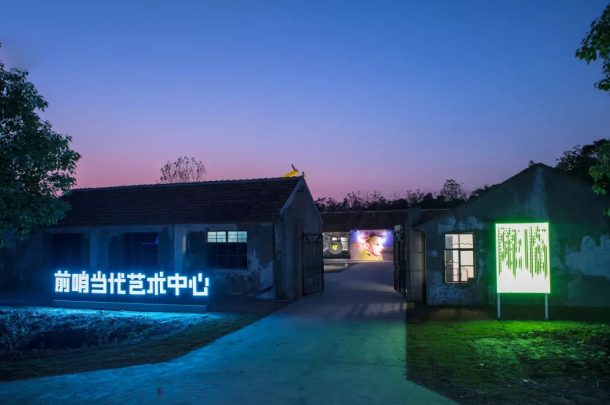
The alluvial island has also been moving, growing, splitting and aggregating since the 6th century, long before sent down youths built cofferdams on its wetlands with bare hands, and new deposits of mud and silt are still rushed up its shores every day. It projects its own temporality distinct from the economically advanced Yangtze Delta where it is situated. The curator Lu Xinghua takes up this micro countercurrent in the inevitable move towards global environmental disaster as a temporary theater where its visitors can work out their own ecological awareness and projects. But such vision, already made vulnerable by the island’s enmeshing within regional and national geo-economic governance, is too mild an attempt at eco-critique with the exhibition’s general laidback aesthetics that most of the time fails to offer cues for non-anthropocentric understanding and feeling one may invent for their relation to organic and nonorganic beings and with(in) the environment. Although the curator proposed an ambitious speculative switch of perspective, through theoretical and practical dislocation of the human species from Earth and re-landing, as a way to acknowledge the human species as an entity of ecological refugees and act responsibly, some works seem to have suffered from permanent amnesia after their trip leaving Earth and forgotten what it felt like to be human on Earth, while others seem to have never left.
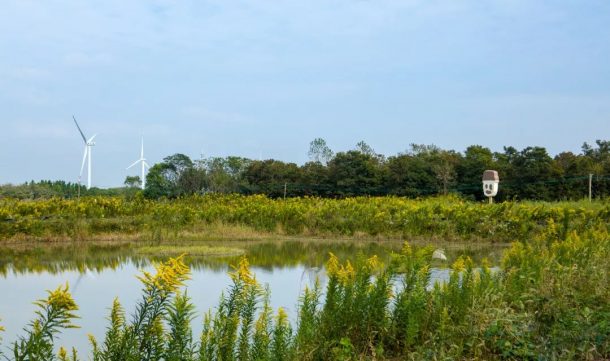
Fiberglass and steel, 650 x 345 x 81 cm
View of “The Advent: Inventing Landscape, Producing the Earth,” Qianshao Contemporary Art Center, Chongming, Shanghai, 2019
The outdoor installations situated along the freshly laid track throughout the forest in Shuxin village appear as if transposing containers of artworks to be shipped for a 2010 biennial onto a randomly given patch of land. Taken as seriously as one would in a white cube, with the deliberately laid cables and spot lamps enclosing each object, the works present themselves more like specimens illustrating what quintessential contemporary art looks like to uninformed visitors. The surrounding unpruned groves and hastily shoveled tracks ironically twist the anthropomorphic and figurative pop sculptures by artists such as Lu Pingyuan, Shi Yong, Xu Zhen, and Shang Liang, from postmodern parody to actual mock art objects in a neighborhood park. The provincial landscape has unapologetically befriended the provincialism of inflated postmodern art against its will.

Stainless steel, 328 x 299 x 134 cm
View of “The Advent: Inventing Landscape, Producing the Earth,” Qianshao Contemporary Art Center, Chongming, Shanghai, 2019
Despite the overall out-of-place quality of the outdoor installations, certain works attempt to assert their objecthood anyway. The bulky, solid chunk of metal of Wang Jianwei’s Nickel, Nature and the Environment, in fact carefully forged from thin layers of steel, flickers between the immaterial and the material under the noon sun along the river that runs through Shuxin Village. Its polished wavy surface appears to be eternally dissolving into the gleaming gush of black water while the weighty block of nickel rises up from the concrete base, cracking into half along the way, as if freshly released from a thousand miles underground. The object’s forceful rawness and fluidity at once remind viewers of the element’s bare materiality in the sense of geo-history and its plasticity and versatility in its recent soldering with human’s industrial civilization.
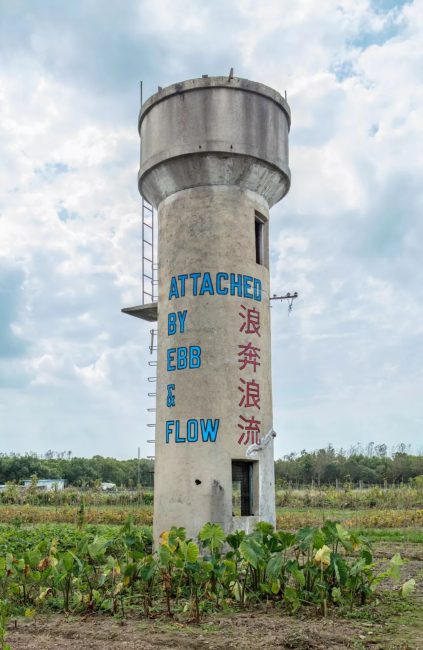
Lawrence Weiner’s site-specific text ATTACHED BY EBB & FLOW on the concrete surface of an abandoned water tower, on the other hand, camouflages itself in the farm fields in a typography reminiscent of commonplace propaganda text painted on walls in the rural area. It works out a poetic equivocation with its subtle Chinese translation taken from the 1980 Sinophone classic “The Bund” drama series, indicating the inexorable radical renewal in an epoch of great change and the eternal flow of tides that has brought the island into existence and will continuously shape it.
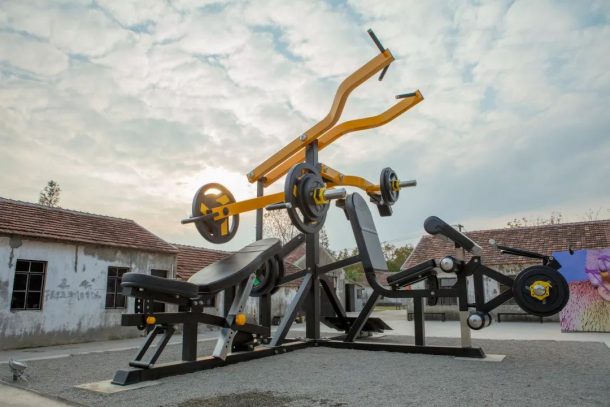
View of “The Advent: Inventing Landscape, Producing the Earth,” Qianshao Contemporary Art Center, Chongming, Shanghai, 2019
From Xu Zhen’s gigantic, misogynistic Evolution—Multi-functional trainer churning out neoliberal fetish for the masculine alpha body nonstop, jutting out of the humble courtyard of the bell factory from the socialist period, to several artists’ dystopic mash-up of any section of a tree and unrecyclable industrial garbage and tech gadgets, sprayed with neon colors and twisted into anthropomorphic forms, the display at the largely unmodified factory fed its viewers some expired 9th Berlin Biennale recyclables that taste like stimulants made in the accelerationist, post-apocalyptic new world.
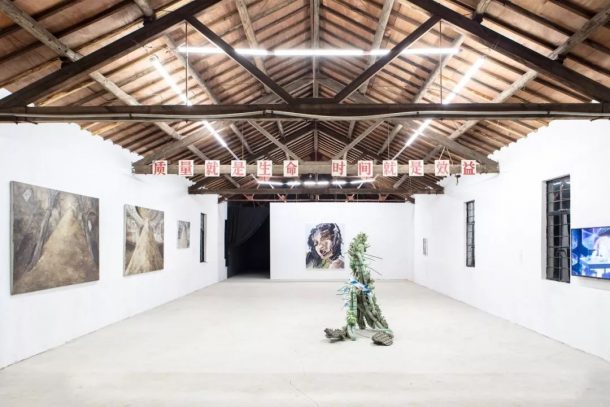
View of “The Advent: Inventing Landscape, Producing the Earth,” Qianshao Contemporary Art Center, Chongming, Shanghai, 2019.
Thankfully, some works have demonstrated that just letting things be is also doable. Martin Creed’s Work No. 587 and Liu Jianhua’s Each is a Piece of the Continent are life forms in different kinds of order. Creed’s cacti lined up in order of height and Liu’s crumbles of rocks made of porcelain both present an unstable, vulnerable sensibility of things experienced in time, evoking a vibrantly bustling objecthood exactly because of their indeterminate life, as quoted in Liu’s statement, “From dust we are born, and to dust we shall return.”
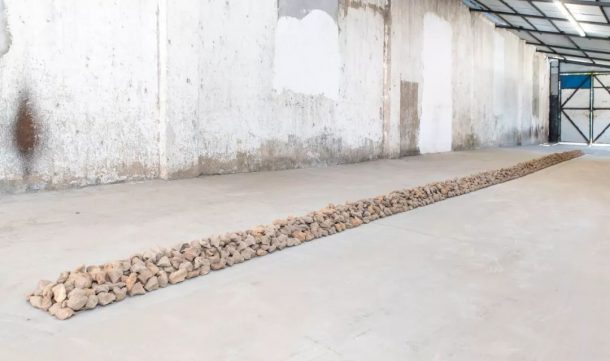
Porcelain, dimensions variable
View of “The Advent: Inventing Landscape, Producing the Earth,” Qianshao Contemporary Art Center, Chongming, Shanghai, 2019
Further destabilizing the human psyche and activating nonhuman presence, Work No. 670, Orson & Sparky by Creed playfully discloses the chaos on set when people shoot films with dogs. 922 Rice Corns” by Yang Zhenzhong joins the animal carnival when two chickens count for human beings simply by pecking on grains. Pecking guides the human counting action in a way similar to when pigeon pecking guided missile movements in the behaviorist experiments in “Project Pigeon”. With animals taking the “organic control” in the feedback process of live reaction to the playback of pecking, it opens up the historically narcissistic, closed feedback loop of early video art. An intimate interspecies relationship emerges from the chickens’ reaction to the grains on the ground and the male and female voices reciting numbers after their actions, and from as far as the human domestication of birds and the everyday rural life cohabited with poultry.
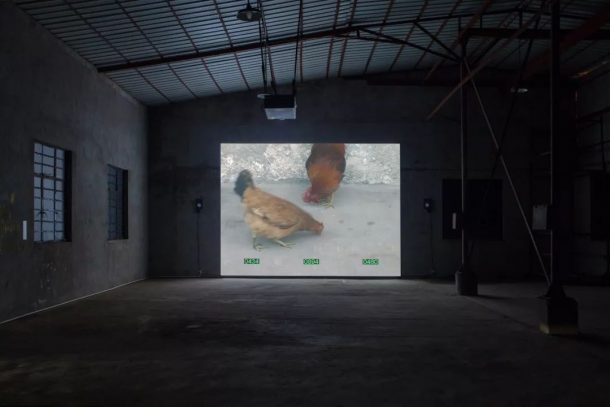
Video, 7 min 59 sec
View of “The Advent: Inventing Landscape, Producing the Earth,” Qianshao Contemporary Art Center, Chongming, Shanghai, 2019
Like the self-conflicting call for viewers to rethink global ecology and to own and invent new landscapes in its curatorial statement, “The Advent” at Qianshao Contemporary Art Center sent out an ambivalent message that tries to put ecological matters into focus through anthropocentric glasses. Although returning after leaving Earth may not be an option if one does so to leave behind the sociopolitical mechanisms and institutions directing global environmental governance and crisis, and art could well become samples of the culture of human civilization drifting in space if artworks insist on safer modes of viewing and storytelling.


